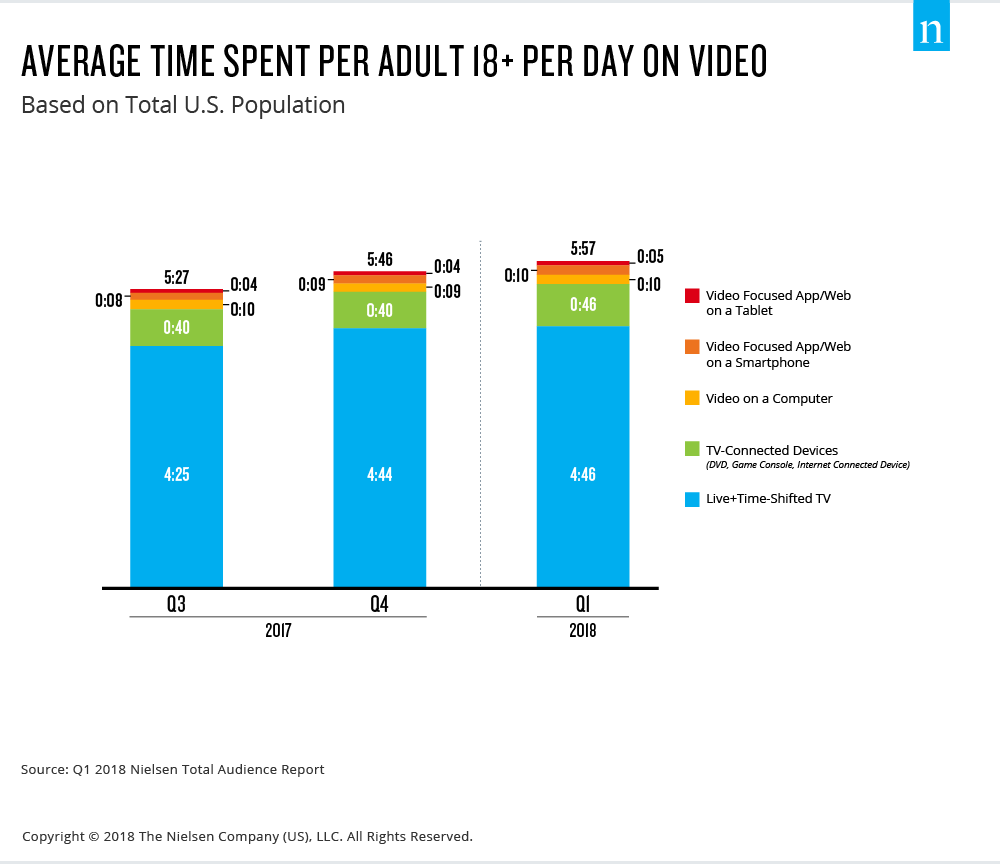Updated on July 18, 2025
It’s official – humans love video. We can’t get enough of it. We watch videos in our homes, at work, during meals and even in the bathroom. A study by Nielsen found that adults in the U.S. watch 6 hours of video every day on their TVs, tablets, computers and phones.

Not only do we spend a lot of time watching videos, but the sheer number of videos we consume each day (5 billion on YouTube, 8 billion on Facebook, plus cable, Netflix and more) is mind boggling. But, if you think we’re watching a lot of video now, just wait. Because in the words of Bachman Turner Overdrive, “b-b-b-baby you ain’t seen n-n-nothing yet.”
In the next couple of years, broadband speeds around the globe are set to double, allowing high definition, interactive, immersive content to download instantaneously over wifi. And 5G mobile networks begin rolling out later this year, allowing us to stream content to our phones and tablets 20x faster than we can today. This supercharged connectivity will so dramatically increase our appetite for video and Cisco predicts that 82% of all internet traffic will be video by 2022. This global shift towards video is causing brands and entire industries to reimagine their communication strategies to be “video first”.
”Video will look like as big of a shift in the way we all share and communicate as mobile has been.
Mark ZuckerbergFounder & CEO of Facebook
If the future of communication is video, then the same holds true for brands, including nonprofits, foundations and corporate philanthropy. However, many of the nonprofits we’ve spoken to are struggling with this new reality. They’ve built their organizations through the tried and true methods of direct mail, email, online fundraising, events and relational fundraising. Their leadership team is willing to allocate budget to a video here and there, but shifting to a video first communications strategy? How can they be convinced of that?
Here are five reasons why video is better than other forms of brand communication.
1. Video is more efficient than other types of brand communication
Plenty of research has demonstrated that our brains are primarily image processing machines. We’ve been using our brains to identify and decode moving images for all of human history, yet we’ve only had pictures and the written word for a few thousand years. Because of this, our brains have a biological bias towards motion and visuals, and the speed at which we can recognize images is a mere 13 milliseconds (it might be even less, but the equipment the researchers were using to conduct the study couldn’t go any faster).
Practically speaking, it takes 60 seconds to read 250 words, but in that same 60 seconds a video could show dozens of images that are rich in color, detail, and context that would require thousands of written words to communicate. Now combine those images with the nuance and resonance of a human voice (the video’s subject or narrator), numerous musical instruments joined together in song (the video’s soundtrack), and endless combinations of design elements and text (graphics and typography) and you begin to appreciate how video is far more efficient in relaying information than any other form of communication.
2. Video storytelling is more engaging than other forms of communication
Neurologists have discovered that when we read facts and figures, only the parts of the brain that deal with language light up. But when we read or hear a story, not only do the language parts of our brains engage, but so does any other part of our brain that we would use if we were actually experiencing what we’re merely reading about! Our brains don’t make much of a distinction between reading about something and experiencing it in real life. Couple the power of story with the fact that 2/3 of people are visual learners, and that presentations using visual aids are more persuasive than unaided presentations, and you can see how video storytelling is more engaging than anything else.
3. Video is shared more frequently than other forms of communication
Our biological bias for visuals and motion (re: for our survival as a species), and the fact that there are fewer opportunities to view video than text and image-based communications (for now at least) results in audiences valuing video more highly than other forms of communication. And what humans value, they share with those they love (their tribe). That’s why video on social media generates 12x more shares than text and image content combined. Additionally, Facebook and Instagram users look at video content 5x longer than static content, and videos receive 135% more organic reach on average than a photo. And Tweets with videos are 6x more likely to be Retweeted than Tweets with photos.
4. Video is preferred over other forms of communication
One of the overarching tenets of marketing is to engage with your audience on their terms in the manner they prefer. Well, the verdict is in and your audiences prefer video over all forms of brand communications. If video and text are both available on the same page, 72% of people choose to watch the video rather than read the copy on the page (including 59% of senior executives). And our preference for video increases as your audience’s age decreases. Your audiences want video, so give them what they want!
5. Video is the future of communication.
The amount of time we spend watching video across all of our devices continues to increase every year. And with the explosion of Internet of Things (IoT) devices, there’s no telling where screens are going to pop up next (your watch, your shower, the dashboard of your self-driving car). If your organization isn’t intentionally incorporating video into your communications plan, not only will your organization be left behind (psychology has proven that FOMO is real!), but your communications won’t be as effective as they could be, and it will be harder to achieve your mission.
What does this mean for nonprofits, foundations and corporate philanthropy?
Like it or not, the future of your organization’s communications will be video. And ultimately, that’s a good thing. Video is more efficient, more engaging, shared more frequently and preferred over any other form of brand communication.
Now that the question of “should we create more video” is settled, you can ask, “What types of videos should we create?” “How do we measure our videos’ effectiveness?” “How do we increase engagement and views?” “Where do we start?” We’ll explore the answers to those questions and more in future articles.

